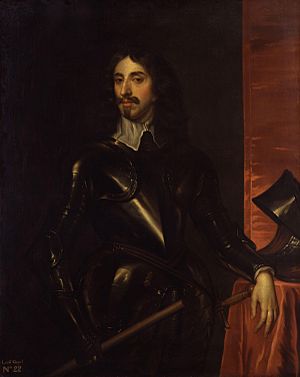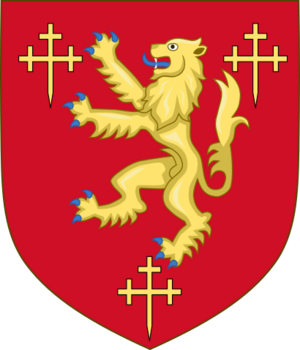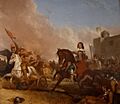Arthur Capell, 1st Baron Capell of Hadham facts for kids
Quick facts for kids
The Lord Capell of Hadham
|
|
|---|---|

Portrait by Henry Paert the Elder
|
|
| Member of Parliament for Hertfordshire |
|
| In office 1640–1641 |
|
| Monarch | Charles I |
| Personal details | |
| Born | 20 February 1608 Hadham Hall, Hertfordshire |
| Died | 9 March 1649 (aged 41) Old Palace Yard, Palace of Westminster, London |
| Nationality | English |
| Spouse | Elizabeth Morrison |
| Relations |
|
| Children |
|
| Alma mater | Queens' College, Cambridge |
| Occupation | Royalist army officer and Member of Parliament |
| Military service | |
| Allegiance | Royalist |
| Rank | Lieutenant-General |
| Battles/wars | English Civil War |
Arthur Capell, born on February 20, 1608, was an important English politician. He lived at Hadham Hall and Cassiobury House in Hertfordshire. He was a Member of Parliament from 1640 to 1641.
In 1641, he became a Baron, which is a type of noble title. He strongly supported King Charles I and the Royalist side during the English Civil War. Sadly, he was executed in 1649 by order of Parliament.
Contents
Early Life and Education
Arthur Capell was the only son of Sir Henry Capell and Theodosia Montagu. His father was from Rayne Hall in Essex. His mother was the daughter of Sir Edward Montagu.
Arthur went to Queens' College, Cambridge for his education. This prepared him for a life in politics and public service.
Political Career and the Civil War
In April 1640, Arthur Capell was chosen to be a Member of Parliament for Hertfordshire. He was re-elected in November 1640 for the Long Parliament.
At first, he spoke out against King Charles I's way of ruling. On December 5, 1640, he presented a list of complaints from Hertfordshire. He continued to criticize the King and his advisors.
Becoming a Baron
In June 1641, the cost to become a Baron was lowered. On August 6, 1641, Arthur Capell was given the title Baron Capell of Hadham.
However, by early 1642, he openly sided with the King. His loyalty was now with the Royalist cause.
Role in the English Civil War
When the English Civil War began, Capell was made a high-ranking officer. He was a lieutenant-general in Shropshire, Cheshire, and North Wales. He helped the King's army there.
Later, he became an advisor to Prince Charles Stewart, who would later become King Charles II. He also took part in peace talks at the Treaty of Uxbridge in 1645.
He went with the Queen, Henrietta Maria of France, when she fled to France in 1646. But he didn't agree with Prince Charles going there. After that, he moved to Jersey. He later helped the King escape to the Isle of Wight.
Capture and Execution
Capell was a main Royalist leader in the Second English Civil War. On August 27, 1648, he surrendered to Lord Fairfax at Colchester. He was promised that his life would be spared.
However, this promise was later said not to apply to the government. His future was uncertain. He managed to escape from the Tower of London by wading across the moat. But he was caught again by a boatman on the Thames.
He was sentenced to death by Parliament on March 8, 1649. He was executed the next day, along with the Duke of Hamilton and the Earl of Holland.
Lord Capell's Heart
Before he died, Lord Capell asked for his heart to be buried with King Charles I. After his execution, his heart was kept in a silver box.
The silver box was looked after by the Bishop of Winchester. Later, the Bishop gave it to King Charles II. In 1703, a heart in a silver box was found at Hadham Hall. This suggests the King might have sent it to Capell's son.
The heart was then taken to Cassiobury. But since the Cassiobury estate was sold, no one knows where Capell's heart is now. A memorial stone for Lord Capell is at St Cecelia's Church in Little Hadham, Hertfordshire.
Writings
Arthur Capell wrote a book called Daily Observations or Meditations: Divine, Morall. It was published in 1654, along with some of his letters.
It was printed again in 1683 with a short story about his life. This new version was called Excellent Contemplations.
Family Life
On November 28, 1627, Arthur Capell married Elizabeth Morrison. She was the only child of Sir Charles Morrison. Elizabeth brought the Cassiobury estate into the family.
This made Arthur Capell one of the richest men in England. His lands were spread across ten counties. He earned about £7,000 a year from them.
He and Elizabeth had four daughters and five sons, including:
- Anne Capell, who married John Strangways.
- Mary Capell (1630–1715), who married Henry Somerset.
- Arthur Capell, 1st Earl of Essex (1631–1683), his oldest son. He became the Earl of Essex later.
- Elizabeth Capell (1633–1678), who married Charles Dormer.
- Henry Capell, 1st Baron Capell of Tewkesbury (1638–1696), a politician. He helped start the Royal Botanic Gardens at Kew.
- Charles Capell (died 1657).
- Theodosia Capell (died 1661), who married Henry Hyde.
Images for kids
-
Lord Cappell fighting at the Siege of Colchester in 1648. Painting by Abraham Cooper.





